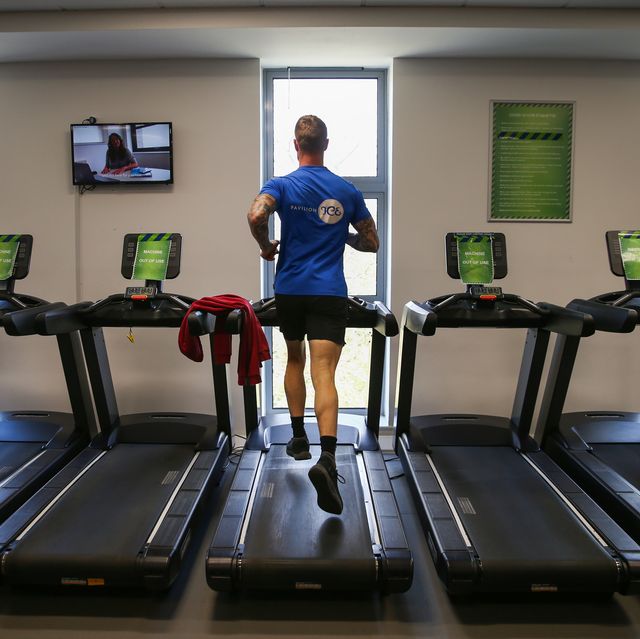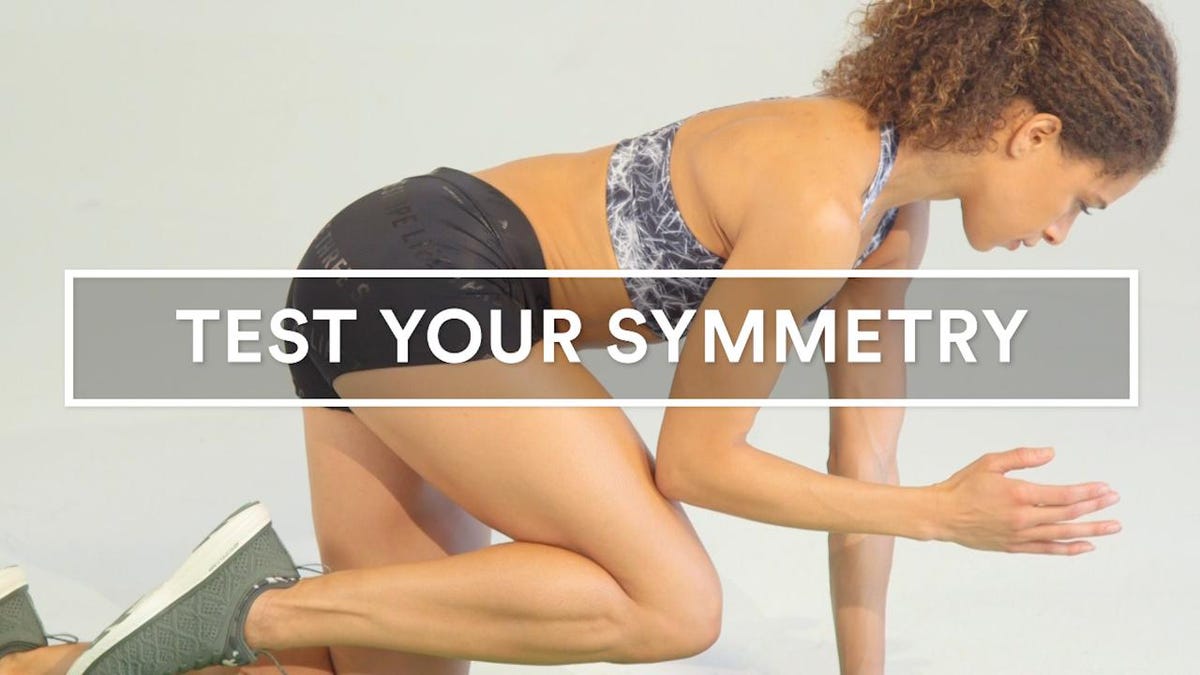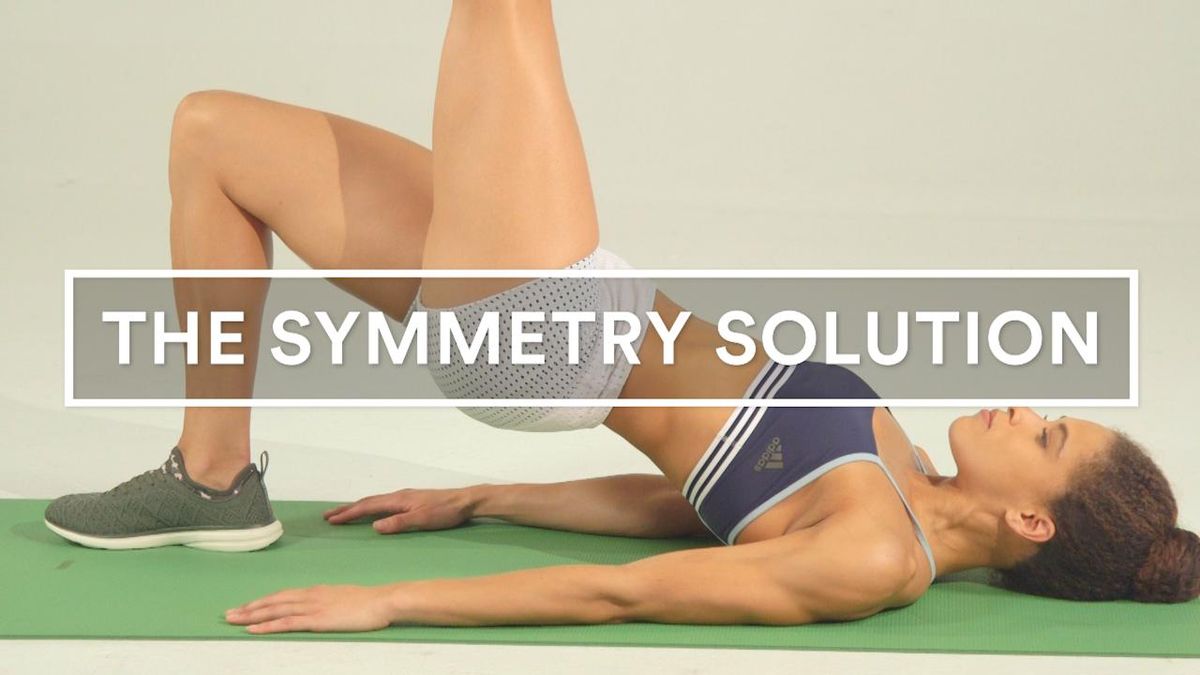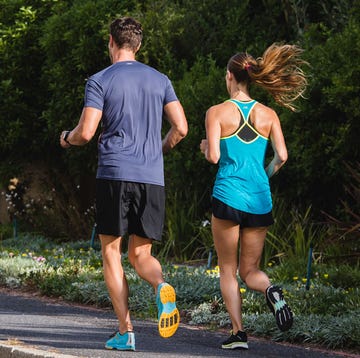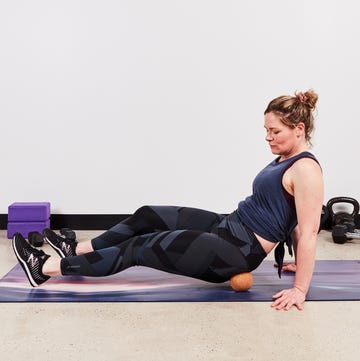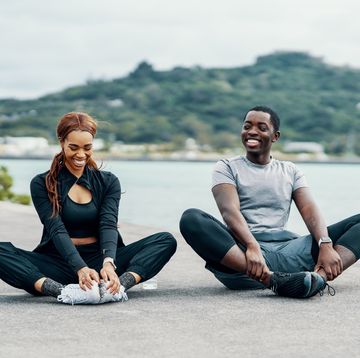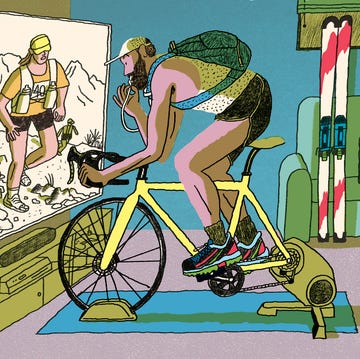You’ve heard about symmetry before: It’s a mathematical principle that denotes exact equality on two sides. A butterfly’s wings. A snowflake. Your face. Some elementary school teacher probably taught you about this years ago, and you likely haven’t thought about symmetry since. But you should, especially when it comes to running. An asymmetrical body — a.k.a. one with muscle imbalances — could be the culprit behind a nagging injury or even what’s keeping you from finally nailing a new PR.
“Evaluating and working on symmetry is one of the top tips I would give new and veteran runners alike,” says Michael Johnson, four-time Olympic gold medal winner and founder of the Michael Johnson Performance training programs. “It can lead to efficiency, which is very important for both sprinters and distance runners. The more efficiently you run, the faster you can cover distance, and the less fatigued you will be because you’ve eliminated or minimized wasted motion.”
When you run, your body is moving in all three planes of motion, explains David Reavy, a Chicago-based orthopedic physical therapist. “You’re going forward and back in the sagittal plane, and your body is also twisting, which is movement in the transverse plane,” he says. “Meanwhile, the feet move in the frontal plane.” A symmetrical body sans muscle imbalance means there’s an equilibrium of work and energy in those three planes—your muscles are all working together as one unit, Reavy says.
Sadly, none of us will ever be perfectly symmetrical because, well, we’re not robots. Even Usain Bolt, one of the greatest sprinters of all time, has made headlines for an asymmetrical gait. Still, “of all the athletes that we work with,” says Lance Walker, the global director of performance at Michael Johnson Performance, “runners can potentially yield the most performance and injury-prevention benefits from symmetry.” In short: If you can identify—and correct—your muscle imbalances, you’ll tap into stores of running potential.
Why addressing imbalance matters
At the end of the day, all runners want to get better at their sport and prevent injury. Symmetry plays a crucial role in both.
“If a runner is asymmetrical, one part of the body may have to work harder than the other to compensate for weakness. That doesn’t mean you’re definitely due for an injury, but it increases the likelihood,” says Joe Holder, a Nike+ Run Club coach and trainer. “Runners have some of the highest incidences of injuries, and a lot of that has to do with not properly fixing muscular imbalances.”
Take, for example, a runner who is quad-dominant, meaning they rely heavily on the quadriceps for force. If you are constantly working those muscles—instead of equally recruiting their counterparts, the glutes and hamstrings—you’re likely to end up with a quad strain, IT band syndrome, or knee pain, says Reavy.
Even if your muscle imbalances don’t manifest as injuries, that doesn’t mean they aren’t holding you back. Imagine an 8:00/mile runner with an imbalance in his hip flexors. That asymmetry could cause the glutes to power down, Reavy says, freezing the runner at that eight-minute pace because he can’t tap into more glute strength. “When more muscles are brought to the party, you don’t fatigue as quickly because your whole body absorbs force, versus placing it all on a certain area,” he adds.
The first step to correction and potentially better performance? Pinpointing those areas of inefficiency.
How to pinpoint muscle imbalances
Asymmetries tend to make themselves known under extreme circumstances, like when you’re running a marathon or blasting through a sprint, says Walker. But if you wait until a race to recognize and attempt to correct them, it’ll be too late. “If you haven’t planned your training so that your weakest link doesn’t break under extreme conditions, you’ve set yourself up for failure,” says Walker. “Dumping more volume, or miles, on your system without leveling up in strength, stability, mobility, flexibility, and balance means asymmetries are just going to expose themselves at the worst possible time, leading to a less-than-optimum performance.”
Unsurprisingly, pain is the biggest tip-off that there’s a muscle imbalance. But it may not be where you think. “Eighty percent of the time when you feel an injury, it’s referred pain, which is when it’s felt somewhere other than the actual source,” says New York City-based trainer Kira Stokes. “Pay special attention to one-sided pain or tightness—that’s a clear indicator.”
Your pelvis is a prime example, says Reavy. “The hip and foot are dependent on the pelvis, and the knee depends on the hip and the foot.” So if you feel knee pain, the root cause could be a pelvic imbalance, he says.
Paying closer attention to how your body feels during strength training can help you zero in on problems. “If you’re doing a glute-specific exercise, do you feel your glutes working? There are primary mover muscles and secondary mover muscles; if you’re doing a squat correctly, your glutes should take the primary load,” says Reavy. “That’s something you can clearly feel.”
Your phone can be a helpful tool, too. Have someone take photos and videos of you at the beginning, middle, and end of a run. “Analyze them and ask yourself: What’s happening to my knees when my foot strikes? Are they going in or out? And how high is my kick? Are my arms crossing the front of my body? All of those things can be clues to whether your body is out of alignment,” says Stokes.
There’s even wearable foot-bed technology that can tell you how symmetrical your stride is: Athletes at Michael Johnson Performance use RPM2 ($499), a footbed-measurement device that provides data related to deficiencies in gait, range of motion, force, and power. Nurvv, a shoe insole, also helps you zero in on your run form and efficiency. And Walker believes there’s more symmetry-promoting technology to come. “Right now, we’re only really measuring time, distance, and heart rate,” he says. “But when you drive a car, you don’t look at how far it’s gone, how fast, and how much gas it used without glancing at the tire pressure, too. Analyzing symmetry gives you a clearer, more well-rounded picture of what’s going on.”
How to fix muscle imbalances
There is no cure-all for asymmetry. Just as every runner’s gait is different, imbalances unravel in unique ways. “It’s about getting to know your own body, and having people whom you trust take an objective, quantifiable look to help you identify where you can improve,” says Walker.
First, make an appointment with a physical therapist who has a strong background in manual therapy. “This means they’re trained to identify muscular and skeletal imbalances, and many offer free screenings,” says Reavy. “They can tell you what your alignment looks like, examine flexibility, and tell you what muscles are and aren’t firing.” From there, your PT can prescribe exercises that are appropriate for improving your specific weaknesses.
In general, though, Holder recommends that runners incorporate microcycles of one-sided strength work (think single-leg squats and glute bridges), plus exercises that work multiple planes of motion at once to ensure the body is equally challenged.
That’s where these workout routines come into play. To really address your muscle imbalances, you want to first screen for asymmetries. Then, treat those issues with targeted strength exercises. Here's exactly what to do.
6 exercises to test for muscle imbalances
The best way to spot asymmetries? Record yourself doing the exercises in this video, then look for the clues mentioned below that point to muscle imbalances.
In-Line Lunge
Start in a narrow lunge, right heel aligned with ball of left foot. Hold a towel vertically down your spine, right elbow pointed toward ceiling and left hand at lower back. Lower into a lunge, keeping towel straight. Stand back up. Repeat.
Pay attention to: Front knee. If it’s moving away or toward the midline, it could mean an imbalance in the hips and glutes.
Deep Overhead Squat
Start with feet slightly wider than shoulder-width apart. Hold a towel and lift overhead. Sit into a deep squat, towel aligned over feet. Press floor away with feet to stand back up. Repeat.
Pay attention to: Knees and heels. If the knees cave in, that can indicate hip weakness. If the heels come off the ground, that means calves may be tight, limiting ankle mobility.
Hurdle Step-Over
Stand in front of a hurdle or step with feet together, holding a towel directly overhead. Lift knee to step over the hurdle and bring your heel to the floor. Step back to start. Repeat on other side. Continue alternating.
Pay attention to: Path of your front leg. If you kick the leg out, you could be lacking hip mobility or strength.
Triceps Push-Up
Start at the top of a push-up position, elbows tucked in by your sides. Lower body to floor, or as close as possible, bending elbows and keeping them tucked toward torso, and maintaining a straight line with your entire body. Press back up. Repeat.
Pay attention to: Butt and shoulders. If you’re “worming” up butt first, that could signal core weakness. If your shoulder blades aren’t moving in sync, there may be an imbalance in your postural muscles.
Thoracic Spine Rotation
Start on all fours, spine in a straight line. Place left hand behind head. Rotate left elbow toward right forearm as far as possible. Reverse the motion, rotating left shoulder upward. Switch hands and repeat on other side.
Pay attention to: Your rotation, or lack thereof. If you are able to rotate farther on one side, that may indicate an imbalance in core mobility and flexibility.
Same-Side Bird Dog
Start on all fours with a neutral spine. Extend right arm and leg, keeping hips and shoulders square to floor. Hold for a few seconds. Return to start and repeat on the opposite side. Continue alternating.
Pay attention to: Your positioning, and overall ability to perform the move. If you’re leaning too far to one side, or you simply can’t do the exercise, you may have weakness or instability in your pelvis and core.
6 strength exercises to fix muscle imbalances
Perform the indicated reps of each exercise below. Rest for 60 seconds at the end of the circuit. Repeat the full circuit a total of 3 times.
Single-Leg Tap
Works hamstrings, glutes, and improves stability
From a standing position, lift left foot and hinge forward at the hips, keeping hips square ground and body in one straight line, until you can tap left fingertips to the floor. Return to starting position without letting left foot touch floor. Do 10 to 12 reps. Then switch sides.
Single-Leg Squat
Works hips, quads, glutes, and improves hip stability
Stand on left foot with right foot lifted slightly off floor. Lower into a squat, sending hips down and back and keeping your right foot lifted (reach arms out for balance). Press through left foot to stand back up. Do 10 to 12 reps. Then switch sides.
Single-Leg Glute Bridge
Works glutes, improves core control
Lie faceup with feet planted near butt, arms at sides. Extend right leg toward ceiling, foot flexed. Squeeze glutes to lift hips as high as you can. Keep back flat, making sure not to lift with low back. Hold at the top for 2 seconds, then lower back down, hovering hips just above the floor. Do 10 to 12 reps. Then switch sides.
Side-Lying Leg Lifts
Works core, hips, glute medius, and improves hip stability
Lie on right side, legs and hips stacked. Extend bottom arm overhead to rest head on shoulder, and place top hand on floor in front of chest. Squeeze thighs together and lift legs several inches. Hold for 2 seconds. Lower legs to hover above floor. Do 10 to 12 reps. Then switch sides.
Clamshell
Works hip abductors, glutes, and improves hip rotation
Lie on right side, knees bent 90 degrees and stacked. Rest head in right hand and place left hand on floor in front of chest. Keeping heels together, raise left knee toward the ceiling, rotating from the left hip and engaging glutes. Return to starting position. Do 10 to 12 reps. Then switch sides.
Compound Bird Dog
Works core, and improves stability
Start on all fours, wrists under shoulders and knees under hips, back flat. Lift right arm and left leg and extend away from torso. This is your starting position. Pulse arm and leg up an inch and down an inch twice. Bend right elbow and left knee under torso until they touch. Return right arm and left leg back to starting position. Simultaneously move right arm and left leg straight out to sides to about the 2 o'clock and 8 o'clock positions. Return to starting position. Do 10 to 12 reps of the entire sequence. Then switch sides.

